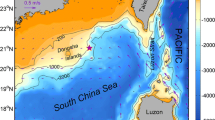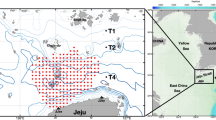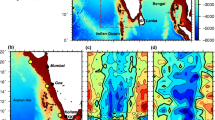Abstract
The seasonal and spatial variation of the current structure and volume transport across the Jeju Strait (JS) is described based on an analysis of the data from five bottom mounted acoustic Doppler current profilers from February 13, 2020 to February 23, 2021. The current was weak and the mixed layer was well developed in winter, so the vertical current shear was not large. Whereas in summer, the inflow of high-temperature and low-salinity surface water built up the stratification, and the surface current velocity increased, resulting in a large vertical current shear. One salient feature to be found was that a westward flowing counter current in the lower layer appeared from June to December near the bottom trough of the JS. We named this seasonal counter current in the lower layer the Jeju Strait Under Current. The eastward net volume transport passing through the JS was large in summer–autumn and small in winter-spring, but did not follow a simple sinusoidal pattern. The annual mean net volume transport was 0.48 Sv (Sv ≡ 106 m3 s−1), with a minimum (0.27 Sv) in December and a maximum (0.79 Sv) in October 2020. When there were strong northerly winds in winter, a net volume transport to the west was temporarily caused by Ekman transport, but the direction reverted to the east as soon as the northerly winds lessened. When there were strong northwesterly (southeasterly) winds due to typhoons, the volume transport decreased (increased) sharply and then recovered rapidly.










Similar content being viewed by others
References
Cha S-C, Moon J-H (2020) Current systems in the adjacent seas of Jeju Island using a high-resolution regional ocean circulation model. Ocean Polar Res 42(3):211–223. https://doi.org/10.4217/OPR.2020.42.3.211
Chang K-I, Kim K, Lee S-W, Shim T-B (1995) Hydrography and sub-tidal current in the Cheju Strait in spring, 1983. J Korean Soc Oceanogr 30(3):203–215
Chang KI, Suk MS, Pang IC, Teague WJ (2000) Observations of the Cheju Current. J Korean Soc Oceanogr 35(3):129–152
Cho Y-K, Kim K (1994) Characteristics and origin of the cold water in the south sea of Korea in summer. J Korean Soc Oceanogr 29(4):414–421
Chung C-S, Hong G-H, Kim S-H, Park J-K, Kim Y-I, Moon D-S, Chang K-I, Nam S-Y, Park Y-C (2000) Biogeochemical fluxes through the Cheju Strait. Sea J Korean Soc Oceanogr 5(3):208–215
Fukudome K-I, Yoon J-H, Ostrovskii A, Takikawa T, Han I-S (2010) Seasonal volume transport variation in the Tsushima Warm Current through the Tsushima Straits from 10 years of ADCP observations. J Oceanogr 66(4):539–551. https://doi.org/10.1007/s10872-010-0045-5
Hersbach H, Bell B, Berrisford P, Biavati G, Horányi A, Muñoz Sabater J, Nicolas J, Peubey C, Radu R, Rozum I, Schepers D, Simmons A, Soci C, Dee D, Thépaut J-N (2018) ERA5 hourly data on single levels from 1979 to present. https://doi.org/10.24381/cds.adbb2d47
Huyer A, Sobey EJC, Smith RL (1979) The spring transition in currents over the Oregon continental shelf. J Geophys Res 84(C11):6995. https://doi.org/10.1029/jc084ic11p06995
Kang SK (2002) Two-layer tidal modeling of the Yellow and East China Seas with application to seasonal variability of the M2tide. J Geophys Res 107:6-1–6-18. https://doi.org/10.1029/2001jc000838
Kim I-O, Rho H-K (1994) A study on China coastal water appeared in the neighboring seas of Cheju Island. Bull Korean Fish Soc 27(5):515–528
Kim SH, Rho HK (1997) A study on the residual current in the Cheju Strait. Korean J Fish Aquat Sci 30(4):759–770
Kim S-H, Rho H-K (1998) A study on the assembling mechanism of the Hairtail, Trichiurus lepturus, at the fishing grounds of the Cheju Strait. J Korean Soc Fish Ocean Tech 34(2):117–134
Kim K, Rho H-K, Lee S-H (1991) Water masses and circulation around Cheju-Do in summer. J Oceanol Soc Korea 26(3):262–277
Lee JC (1983) Characteristics of front near the Cheju Strait in early winter. Korean J Fish Aquat Sci 16(2):51–58
Lee S, Oh K-H, Jang S-T, You HY, Park J, Song K-M (2019) M2 tidal current estimation from one-day observation data off the western and southern coasts of Korea. Ocean Sci J 54(1):39–50. https://doi.org/10.1007/s12601-018-0062-7
Lie HJ (1985) Wintertime temperature-salinity characteristics in the southeastern Hwanghae (Yellow Sea). J Oceanogr Soc Japan 41(5):291–298. https://doi.org/10.1007/bf02109236
Lie HJ, Cho CH (2016) Seasonal circulation patterns of the Yellow and East China Seas derived from satellite-tracked drifter trajectories and hydrographic observations. Prog Oceanogr 146:121–141. https://doi.org/10.1016/j.pocean.2016.06.004
Lie H-J, Cho C-H, Lee J-H, Lee S, Tang Y (2000) Seasonal variation of the Cheju Warm Current in the Northern East China Sea. J Oceanogr 56(2):197–211. https://doi.org/10.1023/a:1011139313988
Lie HJ, Cho CH, Lee JH, Lee S (2003) Structure and eastward extension of the Changjiang River plume in the East China Sea. J Geophys Res-Oceans 108(C3):22–21. https://doi.org/10.1029/2001jc001194
Oh K-H, Lee S, Park J, Song K-M, Jung D (2020) Estimation of effective range of HFR data and analysis of M2 tidal current characteristics in the Jeju Strait. Ocean Polar Res 42(2):115–131. https://doi.org/10.4217/OPR.2020.42.2.115
Pang I-C, Hong C-S, Chang K-I, Lee J-C, Kim J-T (2003) Monthly variation of water mass distribution and current in the Cheju Strait. J Korean Soc Oceanogr 38(3):87–100
Senjyu T, Han IS, Matsui S (2009) Connectivity between the interannual salinity variation in the western channel of the Tsushima Strait and hydrographic conditions in the Cheju Strait. J Oceanogr 65(4):511–524. https://doi.org/10.1007/s10872-009-0044-6
Suk MS, Hong GH, Chung SC, Chang KI, Kang DJ (1996) Distribution and transport of suspended particulate matter, dissolved oxygen and major inorganic nutrients in the Cheju Strait. J Korean Soc Oceanogr 31(2):55–63
Teague WJ, Jacobs GA, Ko DS, Tang TY, Chang KI, Suk MS (2003) Connectivity of the Taiwan, Cheju, and Korea straits. Cont Shelf Res 23(1):63–77. https://doi.org/10.1016/S0278-4343(02)00150-4
Acknowledgements
This study was done with the support of the KIOST research project (PEA0011) ‘Influences of the Northwest Pacific circulation and climate variability on Korean water changes and material cycle I—The role of Jeju warm current and its variability’, the KIMST research project (PM63130) ‘Study on Northwestern Pacific warming and genesis and rapid intensification of typhoon’, and the Basic Science Research Program through the National Research Foundation of Korea (NRF) funded by the Ministry of Education (NRF-2016R1A6A1A03012647). We thank the two anonymous reviewers who provided comments to make this paper more complete.
Author information
Authors and Affiliations
Corresponding author
Additional information
Publisher's Note
Springer Nature remains neutral with regard to jurisdictional claims in published maps and institutional affiliations.
Rights and permissions
About this article
Cite this article
Shin, CW., Min, H.S., Lee, S. et al. Current Structure and Volume Transport in the Jeju Strait Observed for a Year with Multiple ADCP Moorings. Ocean Sci. J. 57, 365–380 (2022). https://doi.org/10.1007/s12601-022-00079-7
Received:
Revised:
Accepted:
Published:
Issue Date:
DOI: https://doi.org/10.1007/s12601-022-00079-7




